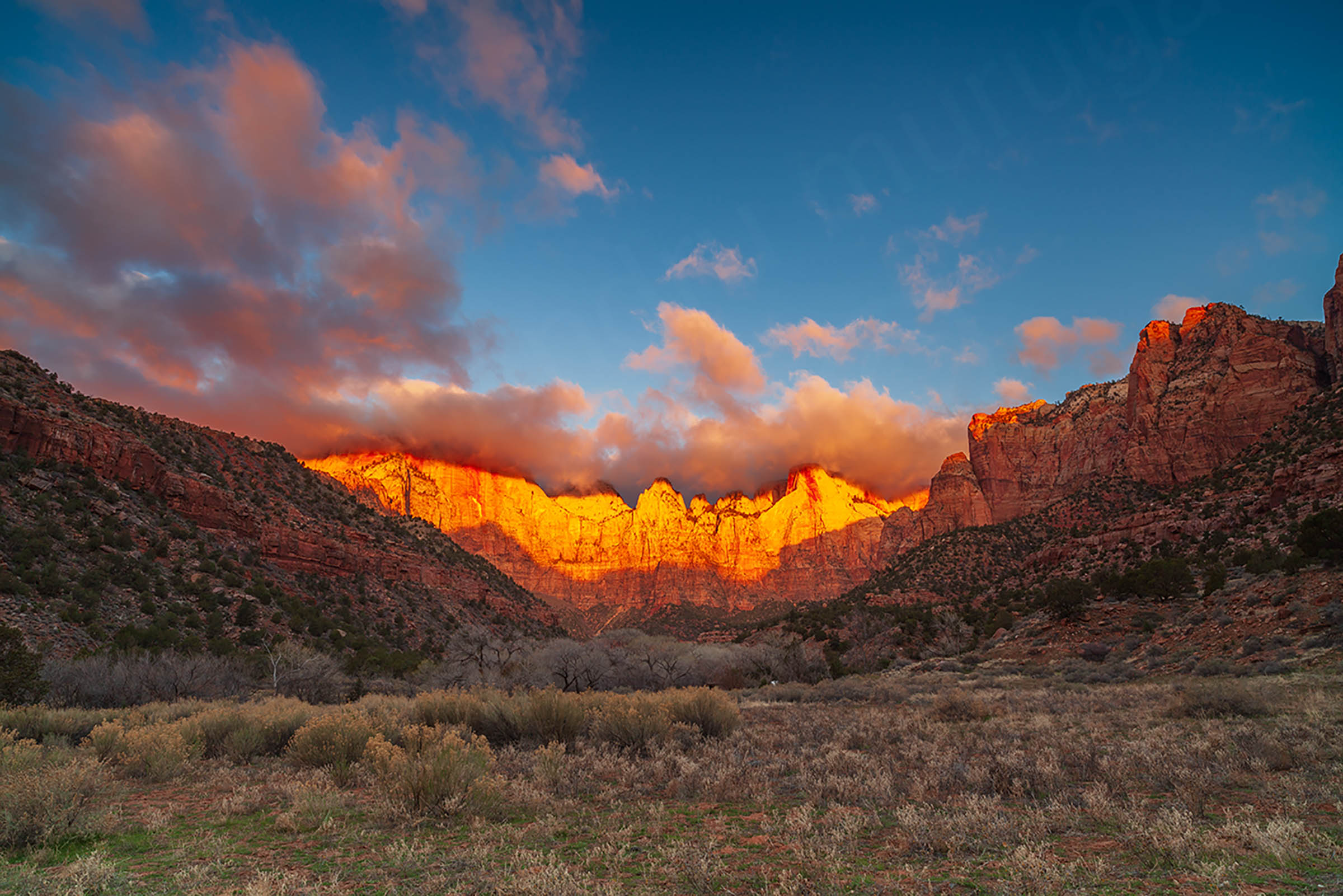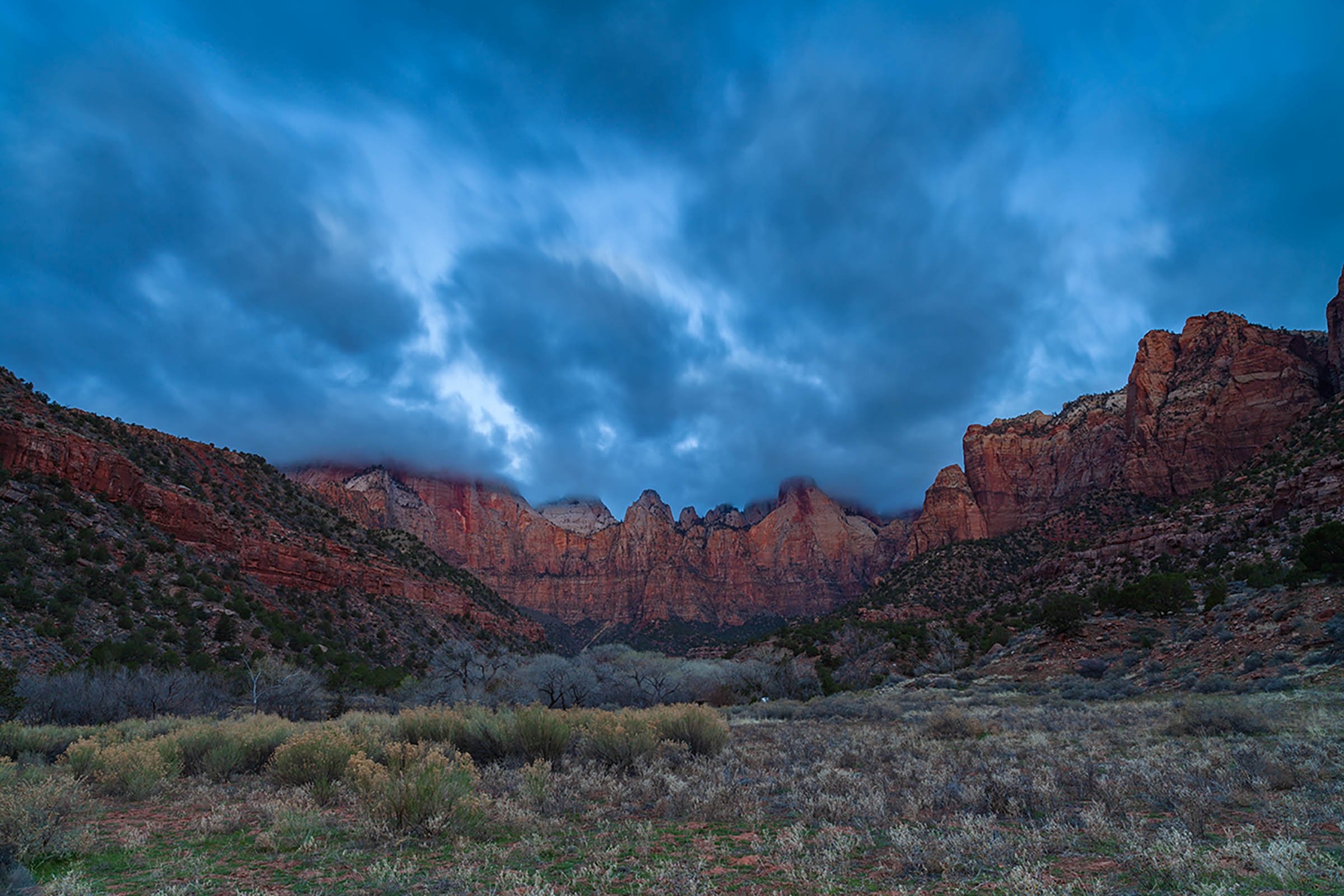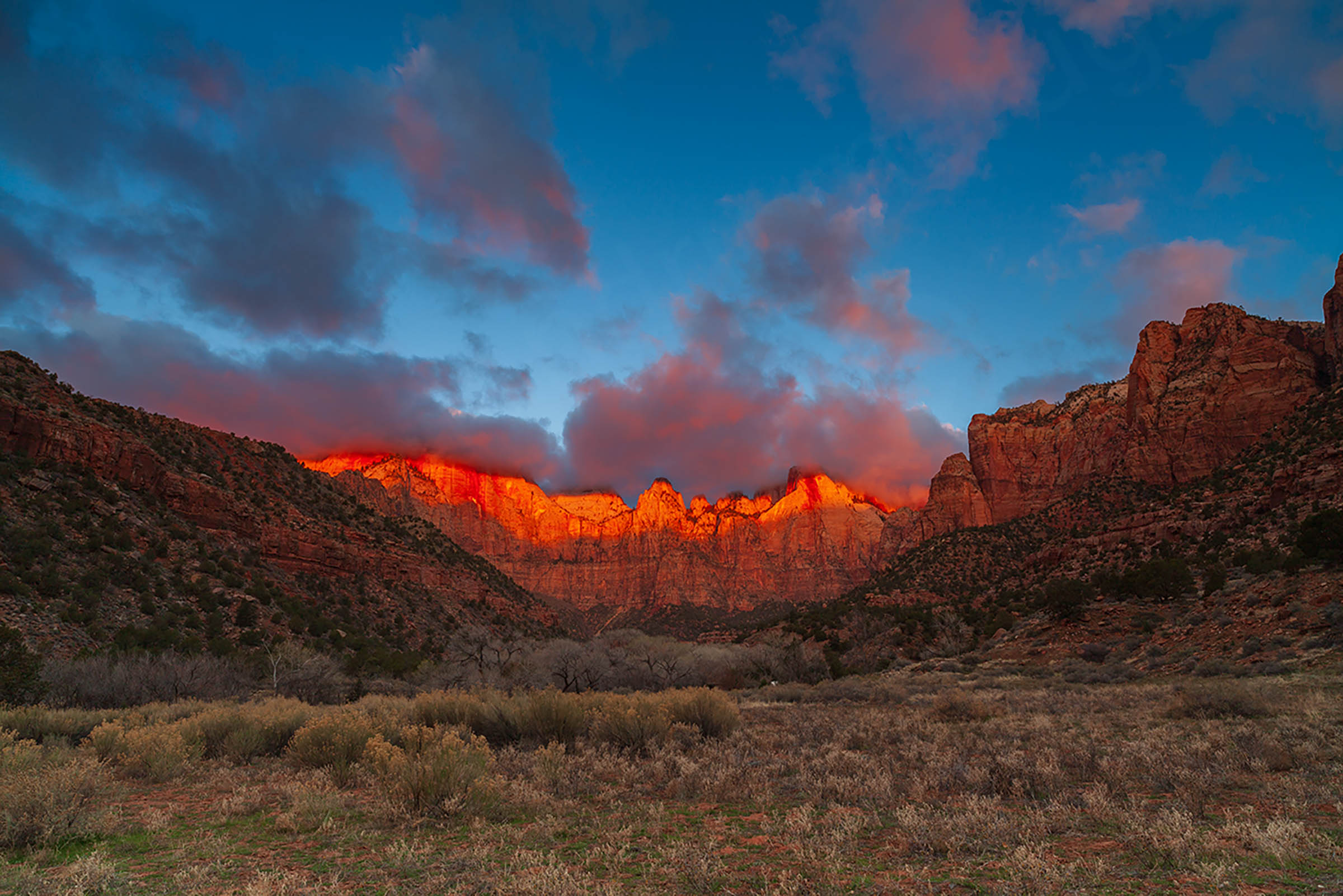‘Temples and Towers of the Virgin’ sunrise at Zion National Park, Utah
An unforgettable alpenglow on the ‘Temples and Towers of the Virgin’ during a March sunrise!
22 January, 2025
~ 7 min read
Heavenly experiences are not limited to just places of worship. If you are a nature lover, you can get an abundance of them, if you can plan well and can sacrifice a bit of early morning sleep!

It was the 5th day of our photography trip through the gorgeous national parks of Utah, in March of year 2014. In an earlier blog, I shared my experience that led me to another epic photo experience at Bryce Canyon National Park and the details of the trip itself. After having had a great day of photography at that park, we headed to another jewel in the American national park system, the Zion National Park.
I believe the distance was less than a hundred miles to our place of stay. The drive itself was less than two hours. As we were driving, I remember noticing the roads were paved with a reddish colored crushed rock. I have never seen roads in that color till then. Later on, while visiting other national parks in the dessert states, I came to know this is more common.
A crucial aspect of landscape photography is knowing exactly where you have to be for the sunrise and sunset hours. Light during the rest of the day is not ideal for the most part, making a tourist’s casual photograph with a point and shoot camera (or even a smartphone these days) as good as what a landscape photographer can shoot. A skilled photographer will still be able to standout with their composition and techniques that can control the light. But even for them there is no equal to shooting under ideal lighting conditions. Photography is about capturing light! For landscapes, nature is the chief lighting technician who doesn’t even talk to the DoP (director of photography)!
As it’s customary, I have researched the place to get to for the next morning’s sunrise. I did this even before the trip began. The book by Laurent Martres, 'Photographing the Southwest - Volume 1 - Southern Utah' was of immense help. The Zion Human History Museum is within the national park boundary. I believe it is also a visitor center as well. You can buy some souvenirs and learn more about the park. During the regular hours of the day, you will probably just stop here to shop/learn or to relieve yourself and think nothing more about this place. But it holds a great secret.
Behind the museum, there is a mountain range very close by. There are couple of peaks known as ‘The West Temple’ and ‘The Altar of Sacrifice’. From the museum’s back side, you can see the mountain range’s east facing side. Like most other geological formations in Utah, these are also mostly sandstone and are naturally tan colored. Shades of yellow, orange and red. You have probably imagined by now what I am about to explain…
When the sun rises, east facing sides of mountain ranges get transformed magically. If the conditions are ideal, i.e., if there are small clouds that can reflect the colors of sunrise, nature creates extraordinary art. The back side of the museum is a front row seat to this immense spectacle. If you happen to be in the Zion National Park during the sunrise hours, you must absolutely plan to be here. What you will do during the rest of the day will be what a majority of tourists will be doing.
The parking lot had a few cars already. The landscape photographer community knows better. Being one among them in these places gives a sense of belonging as we the photographers have the national park and the spell binding views all to ourselves. Me and my buddy parked our vehicle, gathered our gear, and headed to the back side of the building. I was delighted to see a small number of clouds right above the peaks.
I believe we were there about 20 minutes before the sunrise and I surely brought a bit of luck with me. The mountain peaks normally receive the first rays of sunrise a minute or two earlier based on how high they are. And then the light travels down revealing more and more of the mountain. There are apps such as TPE (The Photographer’s Ephemeris) that pin point where the sun (or moon) is going to rise or set, given your GPS location and date. I also carry a simple magnetic needle compass to get an accurate bearing. After observing the space and choosing an ideal spot based on these inputs, I set up the tripod and mounted the camera and began to wait eagerly.

Growing up in India, it is inevitable to hear about Mt.Kailash in the Himalayas. The Hindu belief system considers this as the heavenly abode of Lord Shiva, the god of destruction. Those who have experienced the alpenglow on this peak during the sunrise equate it to a divine experience. After witnessing the sunrise on these ‘temples and towers’ in Zion National Park, I had a glimpse of that exhilaration. What unfolded for approximately the next twenty minutes was a memory of lifetime!
The tallest peak, the right-most in my view, started getting the initial light. It showed a sample of what was about to unfold in front of us. I started shooting away. About seven minutes later, the top 25-30% of the mountains was glowing as if it was made of pure gold!

A landscape photo requires cameras that can capture a wide dynamic range. When a person views a landscape in real life, the pupil of their eye adjusts as needed while the focus area moves from brightly lit parts (sky, for example) to the darker areas (foreground). i.e., the pupil will open up for darker areas to let more of the light in to the eyes. In a still photo, the camera cannot mimic the dynamic behavior of the eye. The shot has to be exposed with a fixed aperture (f stop) and shutter speed. The sensor’s dynamic range has to compensate for the pupil’s adjustment. During the sunrise and sunset hours, the light in the shaded/darker areas will be even less - requiring maximum dynamic range from the sensor. One possible solution is to use HDR (High Dynamic Range) imaging, but in my experience, it yields a sub-par result. Prior knowledge about the tools at my disposal (photoshop) and the levers that can be pulled during processing helps make intelligent decisions in field.
My mind was racing between 1) shooting as many good pictures as possible before the magical light turned into harsh daylight, and 2) slowing down to enjoy the spectacular event. I wanted to ‘take it all and capture it all’ at the same time. I think I balanced a bit of both. I shot majority of the shots with my ‘one and only’ Zeiss 21mm prime. I used the 70-200mm for some telephoto shots, to get the ‘compression’ - where the background appears to be pulled in thus dramatizing the scale of distant objects.

The equipment: Cameras - Canon 5D Mark II and Canon 40D. The glasses were my beloved Zeiss Distagon T* 21mm/f2.8 ZE and Canon 70-200mm F5 L. The tripod was a Manfrotto 055CXPRO3 Carbon Fiber. Sitting on top was the Acratech GP Ballhead. And the Canon TC-80N3 Timer Remote Controller. I have talked about the Zeiss manual prime lenses in my blog here. This photo is yet another example of how it lets me have the confidence of bringing home something unique, every single time.
The typical adjustments that I do in photoshop for a landscape photograph, especially shot in RAW format, include exposure correction for shadow (dimly lit) areas, highlights/lowlights, sensor dust correction, color temperature adjustments, mild vibrance & saturation adjustments, and filters for the sky (to reduce exposure). As always, the photo of this story was processed very carefully to bring it close to how I witnessed it. It is a single shot and involved no tricks. It is a personal favorite of mine, reminding me of the heavenly experience that day!